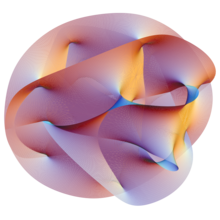超弦理论
超弦理论(英语:Superstring Theory),属于弦理论的一种,有五个不同的超弦理论。超弦理论旨在探寻一可统一各基本作用力及解释基本物质的理论,透过严谨的数学框架来定义和赋予物质质量、解释万物运行规则。也指狭义的弦理论。是一种引进了超对称的弦论,其中指物质的基石为至少九维时空中的弦。
理论基础
[编辑]- 十一维时空(十维空间加一维时间)
为了将玻色子和费米子统一,科学家预言了这种粒子,由于实验条件的限制,人们很难找到这种能够证明弦理论的粒子。超弦理论作为最为艰深的理论之一,吸引着很多理论研究者对它进行研究,是万有理论的候选者之一(指小至可来解释我们所知的一切作用力,大至于解释宇宙所有物理奥秘的全面性理论)。
弦理论中的超对称
[编辑]
弦理论是我们知道的唯一能融合广义相对论和量子力学的方式,但只有超对称的弦理论才能避免快子问题,才能包括费米子振动模式从而才能说明组成我们世界的物质粒子。为了实现引力的量子力学,也为了一切力和物质的大统一,超对称性与弦理论手拉手地走来了。假如弦理论是对的,物理学家希望超对称性也是对的。
主要类型有:
若纳入对偶性以及超重力,则可统一出M理论的框架,常见的对偶有T对偶、S对偶、U对偶。
怀疑论
[编辑]- 1979年诺贝尔奖得主、美国物理学家谢尔登·格拉肖(Sheldon Lee Glashow)是超弦理论的怀疑者,因为其不能提供实验可检验的预言。他曾经试图阻止超弦理论家进入哈佛大学物理系,但是哈佛大学还是接受了超弦理论,于是他选择了离开。[1] 在约十分钟《弦论这件事》(《优雅的宇宙》第二部分)的采访中,他认为超弦是一门与物理没有关系的学科,并且说:“...你可以把它称为肿瘤...”[2]。
注释
[编辑]- ^ Jim Holt, "Unstrung", The New Yorker, October 2, 2006. [2014-07-28]. (原始内容存档于2011-06-06).
- ^ "there ain't no experiment that could be done nor is there any observation that could be made that would say, `You guys are wrong.' The theory is safe, permanently safe." He also said, "Is this a theory of Physics or Philosophy? I ask you" NOVA interview (页面存档备份,存于互联网档案馆))
参考文献
[编辑]- Kaku, Michio. Introduction to Superstring and M-Theory 2nd edition. New York, USA: Springer-Verlag. 1999.
- Shen, Sinyan. Introduction to Superfluidity 2nd edition. Beijing, China: Science Press. 1982.
- Greene, Brian. The Elegant Universe: Superstrings, Hidden Dimensions, and the Quest for the Ultimate Theory. Random House Inc. 2000.
- Greene, Brian. The Elegant Universe(台湾中文译本《优雅的宇宙》或大陆中文译本《宇宙的琴弦》). W.W. Norton and Co. New York,NY. c1999. ISBN 978-0-375-70811-4
参阅
[编辑]外部链接
[编辑]
| ||||||||||||||||||||||||||||||||||||||||||||||||||||||||||||
| |||||||||||||||||||||||||||||||||||||||||||||||||||
Text is available under the CC BY-SA 4.0 license; additional terms may apply.
Images, videos and audio are available under their respective licenses.

